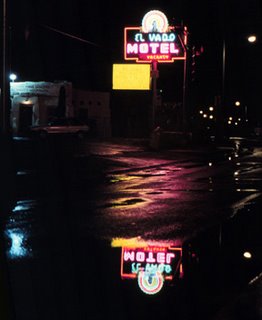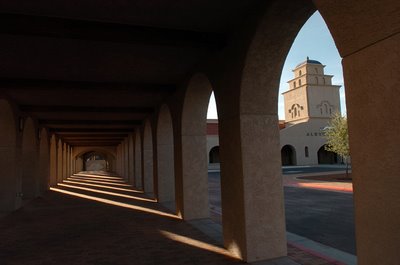 This is the El Vado Motel, located at 2500 Central Avenue S.W., in better days. This picture was taken only a few years ago.
This is the El Vado Motel, located at 2500 Central Avenue S.W., in better days. This picture was taken only a few years ago.Previously, one of its features was the magnificent neon sign with the headdress of the Indian, consisting of five layers of colored neon lights. They would illuminate in an outward sequence and then go dark, just to start over.
Many motels along Central Ave. of the same architectural design, known as pueblo deco, had similar signs of multiple colored neon lights. The lights gave the impression of motion. Signs illustrated wigwagging lines to bucking broncos and exploding lights with strobe bursts.
At one point this motel along with many others created a trail of lights, like a string of pearls, across the city following the path of US Route 66.
In the 1970's the then city commission enacted a very restrictive sign ordinance. It prohibited movement of or motion within a sign.
Unknowingly, the commission changed Albuquerque’s own cultural outlook in this single act. Vibrancy within the town died.
In the past few years, the El Vado deteriorated as its clientele changed. It was a high-end motel in 1937. The travelers of today stay in accommodations several times larger and much quieter.
Too often, today’s customers of the string of deteriorating motels are known for being just above homeless, engaged in prostitution, and involved in the manufacturing and sales of drugs.
Instead of conducting regular and routine inspections, citing and allowing proprietors the chance to rectify deficiencies, the city conceived its own harsh tactics. Targeting problem motels based on police calls for service, they then waited until they had gathered several complaints.
The city then swoops down on deteriorating motels with multi agency raids. The agents compile and cite the owners with multiple charges. They close the establishment as being substandard, giving owners a limited amount of time to bring the property back into compliance. The ultimate effect between taking away the ability to earn money and the extreme costs associated with bringing motels back into compliance has the desired effect that the city wants. Owners abandon their establishments rather than face bankruptcy and loss of their property.
Several motels were targeted and eventually closed and demolished by the city.
The El Vado was sold to Richard Gonzales who proposed tearing down the motel to build townhouses. The property backs up to the Albuquerque Country Club’s golf course and he wanted to capitalize on the view. None of the motel’s units allowed for the view.
 The El Vado is now pad locked.
The El Vado is now pad locked. Route 66 enthusiasts protested. Mayor Martin Chávez held a press conference calling the motel a jewel. He asked that the Environmental Planning Commission not grant a zoning request that would allow for its destruction.
The city’s Landmarks and Urban Conservation Commission approved a resolution recommending the El Vado Motel/Auto Court for designation as a city landmark.
Gonzales promised to maintain part of the motel; the sign, the office and a couple of units. After a February council meeting a moratorium until June 1 was put in place. No demolition permit has been granted.
 This is not the first time a Central Ave. hotel has faced a belated effort to save it.
This is not the first time a Central Ave. hotel has faced a belated effort to save it. The Fred Harvey Alvarado Hotel at the Atchison Topeka and Santa Fe railroad station and the Hotel Franciscan at Central Ave. and Fifth St. N.W. were demolished in the early 1970s. Both generated public outcries demonstrating a lot of noise but no money to buy and restore the aging landmarks.
The Hotel Franciscan held a distinction of being the world's tallest freestanding adobe building.
 These are pictures of the recently built Alvarado Transit center at Central Ave. and First Street S.W. and the home of ABQ Ride, the city’s bus system.
These are pictures of the recently built Alvarado Transit center at Central Ave. and First Street S.W. and the home of ABQ Ride, the city’s bus system. 
Several years back, the AT&SF railroad passenger station burned down.
 This past week the Greyhound Bus station opened in a new building that stands where the old rail terminal was. Like the Alvarado center, it recreates the original architectural design.
This past week the Greyhound Bus station opened in a new building that stands where the old rail terminal was. Like the Alvarado center, it recreates the original architectural design.  It seems a nostalgic notion that recreating the exterior architectural designs of a bygone era will somehow bring us back to a reminiscent period.
It seems a nostalgic notion that recreating the exterior architectural designs of a bygone era will somehow bring us back to a reminiscent period. What put “Alburquerque” on the map was the railroad’s arrival in April, 1880. That was before the third “r” disappeared from “Alburquerque.” There seems to be two versions of the story of how the ”r” went missing. Either it was an overzealous and spelling challenged postmaster who struck through the first “r” until the populace started spelling Albuquerque his way, or that the name posted in front of the rail passenger station was misspelled.
What put “Alburquerque” on the map was the railroad’s arrival in April, 1880. That was before the third “r” disappeared from “Alburquerque.” There seems to be two versions of the story of how the ”r” went missing. Either it was an overzealous and spelling challenged postmaster who struck through the first “r” until the populace started spelling Albuquerque his way, or that the name posted in front of the rail passenger station was misspelled. 
Yet it now seems there is also a slow slide in the railroad transportation industry as Congress shows reluctance to continue funding Amtrak.
 The city reneged on an agreement to house Amtrak in the Alvarado or bus centers. Amtrak passenger station is relegated to an old baggage room; one of the few remaining buildings left over from the old hotel/station complex.
The city reneged on an agreement to house Amtrak in the Alvarado or bus centers. Amtrak passenger station is relegated to an old baggage room; one of the few remaining buildings left over from the old hotel/station complex.Regionally, the Rail Runner will soon come on line as a link to the commuter system; the operative word being system. Commuter rail will only work if there is a timely, reliable and cost effective surface system that will get users to their destinations faster and cheaper than they can now do in their cars.
The city has a light-rail system planned to run along Central Ave. and on University Blvd. to the Sunport as a further expansion of a viable commuter system.
1 comment:
Great story. I can't believe the El Vado is closed! It was such a great place. I love Route 66 but it hurts so much to love something that dies a little every single day.
Post a Comment